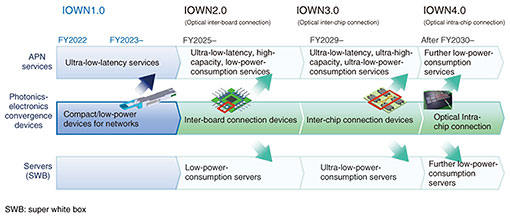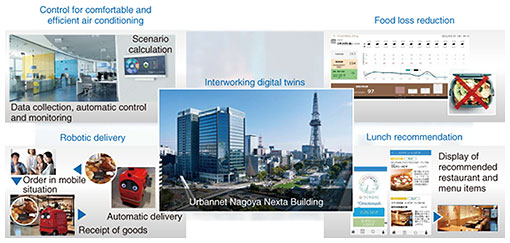 |
|
|
|
|
|
Feature Articles: Keynote Speeches at NTT R&D Forum—Road to IOWN 2022 Vol. 21, No. 3, pp. 16–20, Mar. 2023. https://doi.org/10.53829/ntr202303fa1  IOWN1.0—Start of IOWN ServiceAbstractThis article introduces the Innovative Optical and Wireless Network (IOWN) service that is due to launch in March 2023. It is based on the keynote speech given by Akira Shimada, president and chief executive officer of NTT Corporation, at the “NTT R&D Forum—Road to IOWN 2022” held from November 16th to 18th, 2022. Keywords: IOWN, APN, Digital Twin Computing 1. The future is a data-driven societyWith the spread of Internet of Things (IoT) and new digital services, we are rapidly transforming into a data-driven society, where analysis and actions are based on data. In addition to the vast increase in volumes of data handled in this data-driven society, it is anticipated that the power consumption required for data processing will increase significantly. In terms of data volume, to watch a video in full high definition, for example, requires broadband speeds of 1.5 Gbit/s, but to watch the same video in 16K requires speeds approximately 750 times faster. It is anticipated that the extended reality of the metaverse will grow rapidly, and the move from two-dimensional (2D) to 3D data will necessitate an approximately 30-fold increase in data volume. More and more aspects of our lives will also be networked as part of IoT. It is projected that the number of IoT devices in use will increase 5-fold, from approximately 27 billion in 2017 to 125 billion by 2030 (Fig. 1).
Let’s take a look at the expected increase in energy consumption. Datacenter energy consumption in 2018 stood at 14 TWh in Japan and 190 TWh globally. However, as more data migrates to the cloud, by 2030 it is anticipated that energy consumption will increase significantly, increasing 6-fold in Japan to 90 TWh and 13-fold globally. When we factor in the various new services that will begin to appear, along with the existing services such as large-volume storage and video streaming which today can be used without problems on current high-speed communication networks, extremely lower latency will be essential to enable, for example, the adoption of virtual reality and augmented reality (VR/AR) robots and autonomously driven drones. In VR, unless latency of less than 20 ms is achieved, images appear slower than human movement, causing VR motion sickness. Looking at all the statistical data it is clear that data volumes and energy consumption are anticipated to increase significantly (Fig. 2).
The Innovative Optical and Wireless Network (IOWN) will resolve the challenges relating to data volume, energy-consumption increases, and network latency. Specific performance targets for IOWN are 100 times more energy efficiency and have 125 times more transmission capacity and 1/200 end-to-end latency. 2. All-Photonics Network services (low latency and high capacity)In the first phase of IOWN services (i.e., IOWN1.0), we will launch All-Photonics Network (APN) services in March 2023. They will be 100-Gbit/s leased line services that will provide users with exclusive end-to-end access to optical wavelengths. The service specifications are shown in Fig. 3. The key features of IOWN1.0 APN services are low latency and high capacity. In terms of capacity, a 1.2-fold increase will be provided. Because of transmission as optical wavelengths, latency can be reduced to just 1/200th of current services. In other words, IOWN1.0 will achieve the performance targets initially set for IOWN. Latency fluctuations will also be eliminated. With Internet protocol (IP) and Ethernet service latency fluctuations, it is difficult to predict latency with any certainty, which in turn presents challenges for conducting detailed and complex operations remotely. With IOWN1.0 APN services, latency fluctuations will be eliminated, making it possible to predict a consistent level of latency, and this predictability can be applied to many different services. The capability to visualize and adjust latency means that even when connecting between remote locations it is possible to synchronize timing.
I would now like to give four examples of the ways APN services can be used. First is the field of remote medicine. Low and unfluctuating latency enables the stable operation of precision robots. We believe that this will significantly expand opportunities for remote surgery. We are currently engaged in joint experiments with Medicaroid Corporation, which manufactures and sells the hinotoriTM surgical robot system, and together we plan to contribute to the development of community medicine. Let’s take a look at another example involving the use of robots, i.e., a smart factory. We are looking into the possibilities for operating chemical plants remotely. Chemical plants are enormous and maintenance is very demanding in terms of staffing requirements. It is in these plants that we are planning to use APN services to conduct detailed operations remotely, such as checking equipment and fine-tuning valves in elevated locations and explosion-proof areas. The third example is in e-sports. In e-sports games, where split seconds make the difference between winning and losing, using the low and unfluctuating latency of APN services will make it possible for players in remote locations to enjoy stress-free and fair play. The fourth example is connectivity between datacenters. Using APN services to connect regional datacenters and hyperscale datacenters with high-capacity and low-latency connectivity will make it possible for all locations to be handled as if they were a single datacenter. 3. Photonics-electronics convergence devices (low power consumption of the APN and servers)Next, let me explain the status of the development of a photonics-electronics convergence device that will help achieve low energy consumption. Our APN services will ensure low latency, but perhaps the most significant point about IOWN is improvement in energy efficiency. The key element behind this efficiency boost is the photonics-electronics convergence device. Photonics-electronics convergence is the fusion of optical and electrical circuits to improve performance in various ways, including miniaturization and efficiency as well as boosting speed and lowering energy consumption. By applying photonics-electronics convergence to networks as well as the world of computing, we are seeking to achieve major reductions in energy use. In our roadmap to the implementation of photonics-electronics convergence devices, by FY2023 we aim to have a miniaturized, low-power-consumption device for networks ready for commercial use. We are seeking to reduce power consumption by incorporating what used to be multiple devices into a single, significantly miniaturized package. Specifically, we are planning to have a commercial 400-GB device ready in FY2023 and 800-GB device available in FY2025. Additionally, as devices become smaller, this will enable the miniaturization of network devices, such as transmission equipment, which will lead to simplified operations. In FY2025, we plan to commercialize board-connecting devices that will enable the use of optics for board-to-board and board-to-external interface connections. These advances will make it possible to use photonics-electronics convergence in computing. By FY2029, we aim to use photonics-electronics convergence technology to connect chips within boards, and from FY2030 onwards achieve in-chip connectivity. By applying such photonics-electronics convergence devices to APN services and servers, we will further refine and improve IOWN. In FY2023, we will launch a miniaturized and low-power-usage networked device in our APN services, further helping to boost their energy efficiency (Fig. 4).
As part of IOWN2.0, from FY2025 we plan to expand the scope of application of board connection devices to include not just APN services but also servers. Under our current schedule, by FY2026 the plan is to develop a commercially feasible low-energy-consumption server using such a photonics-electronics convergence device. As part of IOWN3.0, by FY2029 the aim is to have developed chip-to-chip devices, and from FY2030 or thereafter, as part of IOWN4.0, to achieve optical intra-chip connection, thus significantly reducing power consumption. In addition to these photonics-electronics convergence devices, and taking into account anticipated improvements in wavelength and optical fiber technologies, for IOWN2.0 from FY2025, we plan to achieve a 13-fold increase in energy efficiency in the APN sector, an 8-fold increase in efficiency in the server sector, as well as a 6-fold increase in capacity. From FY2029, with IOWN3.0 we anticipate further performance improvements and predict that we will be able to achieve a 125-fold increase in capacity. Although energy efficiency depends on the rollout of technology to devices, from IOWN2.0 we expect to be able to improve performance, achieving a 20-fold increase in the server sector compared with current levels. What is more, from FY2030 and beyond, with IOWN4.0 we are seeking to boost energy efficiency 100 times overall, enhance capacity 125 times, and achieve our target for latency of 1/200th of current levels. 4. Digital Twin ComputingNext, let me say a few words about Digital Twin Computing, which is another IOWN technology. The IOWN framework consists of the APN and server infrastructure, of which photonics-electronics convergence devices are a component, as well as Cognitive Foundation and Digital Twin Computing technologies. Cognitive Foundation means the optimization of all information and communication technology resources and their operation and control. Digital Twin Computing is the ability to predict the future and optimize by combining digital twins in the real and digital worlds. Digital Twin Computing is the process of taking various digital copies of people, objects, and things in real space and expressing these digital copies in cyberspace, using them to perform data analysis and simulations such as predictions about the future. On the basis of the results, the optimal methods and actions are then fed back to the real world to help improve processes and decisions to address challenges in real situations. For example, by linking data on people flows and traffic volumes with basic data on the urban environment, it will become possible to create conditions for controlling an optimal transportation environment. Let me introduce a real example of how Digital Twin Computing is being put to use in urban development. Since FY2022, we have been conducting an urban development pilot project at Urbannet Nagoya Nexta Building using Digital Twin Computing (Fig. 5). At Urbannet Nagoya Nexta Building, we are testing a new initiative to link four services, i.e., air-conditioning control, food loss reduction, robotic delivery, and lunch recommendation, and optimize them on the basis of predictions using Digital Twin Computing.
As you can see, urban development using Digital Twin Computing has already begun. Although currently still in the pilot stages, we plan to commercialize solutions for air-conditioning control and food loss reduction by the end of FY2022. By further expanding our services and deploying them in various urban environments, we aim to contribute to urban development that benefits both people and the global environment. 5. Concluding remarksFinally, let me share with you that at Expo 2025 Osaka Kansai, Japan, NTT plans to present a real-world pavilion and virtual platform to be called “Floating Yumeshima” where every life shines. We hope to be able to announce the launch of IOWN2.0 services at the Expo, so please keep following our progress. |
|













